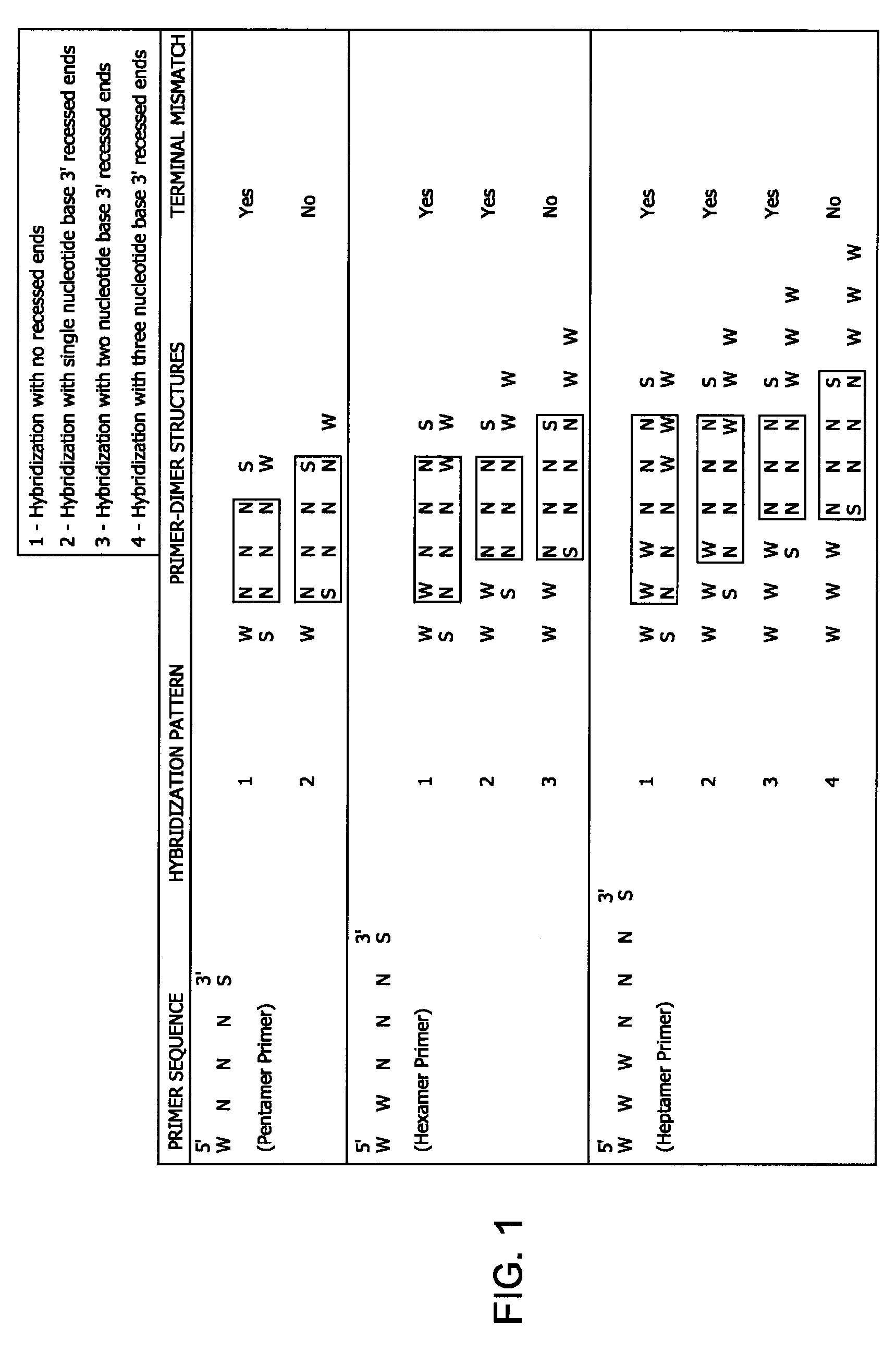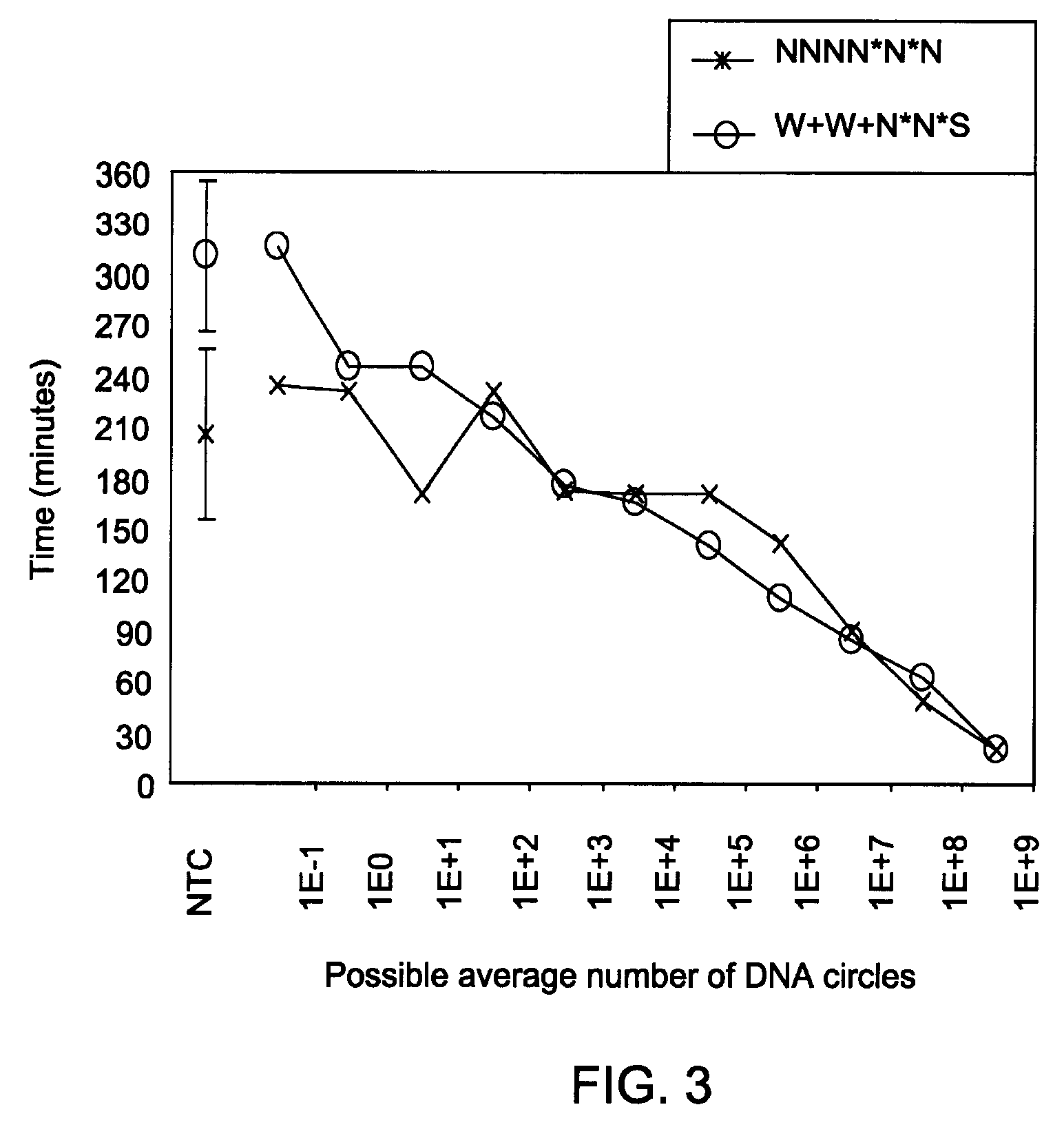Methods and kits for reducing non-specific nucleic acid amplification
a nucleic acid amplification and non-specific technology, applied in the field of nuclei, can solve the problems of high background signal of most of the currently available nucleic acid amplification techniques, wrong diagnosis, and hinder the effective utilization of many of these techniques in critical nucleic acids, and achieve the effect of efficient amplification of nucleic acids
- Summary
- Abstract
- Description
- Claims
- Application Information
AI Technical Summary
Benefits of technology
Problems solved by technology
Method used
Image
Examples
example 1
[0086]The reagents and reagent solutions that were used for nucleic acid amplification reaction were de-contaminated in a nucleic acid-free hood prior to their use to remove any contaminating nucleic acids. The reagents such as Phi29 DNA polymerase, exonuclease I, exonuclease III, and SSB protein were stored in 50 mM Tris-HCl (pH 7.2), 200 mM NaCl, 10 mM DTT, 1 mM EDTA, 0.01% (v / v) Tween-20, and 50% (v / v) glycerol. The primer-nucleotide solution (primer-nucleotide mix) comprising primer and nucleotides (dNTPs) was de-contaminated by incubating the primer-nucleotide mix with a combination of exonuclease I, exonuclease III, and a single stranded DNA binding protein (SSB protein). The enzyme mix comprising a DNA polymerase was de-contaminated by incubating with an exonuclease in presence of a divalent cation (e.g., Mg2+). Any target nucleic acid amplification reaction was performed using the de-contaminated enzyme mix and the primer-nucleotide mix.
[0087]As shown in Table 2, the enzyme ...
example 2
[0092]Non-specific amplification reaction during a nucleic acid amplification reaction was estimated by performing a DNA amplification reaction without any added template DNA (No Template Control (NTC) amplification). The reactions employed either a completely random hexamer primer (NNNN*N*N), or a partially constrained pentamer primer (W+W+N*N*S) that comprises LNA nucleotides, which has a terminal mismatch primer-dimer structure. Both these primers were exonuclease-resistant primers, having phosphorothioate linkages between the nucleotides toward the 3′ end of the sequence.
[0093]The amplification products from a DNA amplification reaction with no added target DNA template (NTC) arise from non-specific amplification reactions (false amplification or background amplification). The non-specific amplification may be due to amplification of contaminating DNA molecules, or it may be due to primer gymnastics (e.g., formation of primer-dimer structures, and subsequent extension of primer-...
example 3
[0098]Higher specificities of DNA amplification with a partially constrained primer is illustrated by performing DNA amplification reactions at varying concentrations of target DNA template. To avoid any non-specific amplification reaction from contaminating DNA, all reagents or reagent solutions (enzyme mix and primer-nucleotide mix) that were used for the amplification reaction were de-contaminated prior to their use following the procedure described in Example 1. The de-contaminated enzyme mix and primer-nucleotide mix were then combined to form a reaction mixture, which was comprised of 40 μM primer (either a random hexamer, NNNN*N*N, or a partially constrained pentamer primer, W+W+N*N*S), 400 μM dNTPs (equal mixture of each of dATP, dCTP, dGTP, dTTP), and 0.3 μM phi29 DNA polymerase (200 ng per 10 μL reaction) in 50 mM HEPES buffer (pH=8.0) containing 15 mM KCl, 20 mM MgCl2, 0.01% (v / v) Tween-20, 1 mM TCEP, and 1:10,000 (v / v) SYBR Green I. The reaction mixture also contained 0....
PUM
| Property | Measurement | Unit |
|---|---|---|
| temperature | aaaaa | aaaaa |
| temperature | aaaaa | aaaaa |
| pH | aaaaa | aaaaa |
Abstract
Description
Claims
Application Information
 Login to View More
Login to View More - R&D
- Intellectual Property
- Life Sciences
- Materials
- Tech Scout
- Unparalleled Data Quality
- Higher Quality Content
- 60% Fewer Hallucinations
Browse by: Latest US Patents, China's latest patents, Technical Efficacy Thesaurus, Application Domain, Technology Topic, Popular Technical Reports.
© 2025 PatSnap. All rights reserved.Legal|Privacy policy|Modern Slavery Act Transparency Statement|Sitemap|About US| Contact US: help@patsnap.com



